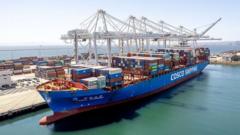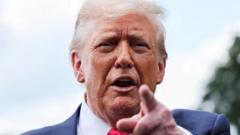As the U.S. aims to bolster its shipbuilding sector, new port fees for Chinese ships may lead to increased consumer costs and global trade disruptions.
**US Implements New Port Fees on Chinese Ships to Revitalize Domestic Shipbuilding**

**US Implements New Port Fees on Chinese Ships to Revitalize Domestic Shipbuilding**
The Biden administration seeks to challenge China's shipping industry dominance by imposing port fees on Chinese vessels.
The U.S. Trade Representative's (USTR) administration has announced a new strategy targeting Chinese ships with port fees as a means to rejuvenate American shipbuilding and counter China's market dominance. This latest initiative is a modified version of a plan proposed earlier this year, which suggested imposing hefty docking fees of up to $1.5 million per visit.
Set to launch in 180 days, the fee structure is designed to increase incrementally over the next three years, causing some trepidation regarding its potential to further strain global trade—currently under stress due to President Joe Biden’s trade policies.
According to the USTR, “China has largely achieved its dominance goals, severely disadvantaging U.S. companies, workers, and the U.S. economy.” The fees imposed on Chinese vessel owners will be contingent upon various factors, including cargo weight, container count, and vehicle numbers. Bulk carriers will find fees calculated at $50 per ton, increasing by $30 annually, while container ships will begin at $18 per ton or $120 per container.
The policy also specifies a cap on fees per ship per journey, with additional exceptions for empty vessels coming to transport U.S. exports. The USTR has signaled that after three years, there will be further restrictions aimed at promoting U.S.-built ships, particularly those transporting liquefied natural gas, to increase over the next two decades.
This announcement arrives amid already heightened global trade tensions brought on by previous tariffs placed by the Biden administration, leading to rerouting cargo originally destined for the U.S. to European ports. Industry analysts have raised concerns, citing that such measures could exacerbate price increases for American consumers and drive congestion in European ports.
Marco Forgione, director general of the Chartered Institute of Export & International Trade, noted a significant backlog of ships at European ports and pointed to a notable uptick in imports from China to the U.K. and the EU in response to the changing dynamics of trade routes. Both tariffs and other logistical challenges at key European ports have compounded these issues.
Logistics professionals are now scrutinizing emerging markets and adapting supply chains as American consumers brace for the inevitable impact of these tariffs. As tariffs rise and shipping routes adjust, the consequences for global trade patterns become increasingly complex, prompting businesses to navigate a landscape ripe with uncertainty and potential surges in costs.
Set to launch in 180 days, the fee structure is designed to increase incrementally over the next three years, causing some trepidation regarding its potential to further strain global trade—currently under stress due to President Joe Biden’s trade policies.
According to the USTR, “China has largely achieved its dominance goals, severely disadvantaging U.S. companies, workers, and the U.S. economy.” The fees imposed on Chinese vessel owners will be contingent upon various factors, including cargo weight, container count, and vehicle numbers. Bulk carriers will find fees calculated at $50 per ton, increasing by $30 annually, while container ships will begin at $18 per ton or $120 per container.
The policy also specifies a cap on fees per ship per journey, with additional exceptions for empty vessels coming to transport U.S. exports. The USTR has signaled that after three years, there will be further restrictions aimed at promoting U.S.-built ships, particularly those transporting liquefied natural gas, to increase over the next two decades.
This announcement arrives amid already heightened global trade tensions brought on by previous tariffs placed by the Biden administration, leading to rerouting cargo originally destined for the U.S. to European ports. Industry analysts have raised concerns, citing that such measures could exacerbate price increases for American consumers and drive congestion in European ports.
Marco Forgione, director general of the Chartered Institute of Export & International Trade, noted a significant backlog of ships at European ports and pointed to a notable uptick in imports from China to the U.K. and the EU in response to the changing dynamics of trade routes. Both tariffs and other logistical challenges at key European ports have compounded these issues.
Logistics professionals are now scrutinizing emerging markets and adapting supply chains as American consumers brace for the inevitable impact of these tariffs. As tariffs rise and shipping routes adjust, the consequences for global trade patterns become increasingly complex, prompting businesses to navigate a landscape ripe with uncertainty and potential surges in costs.






















